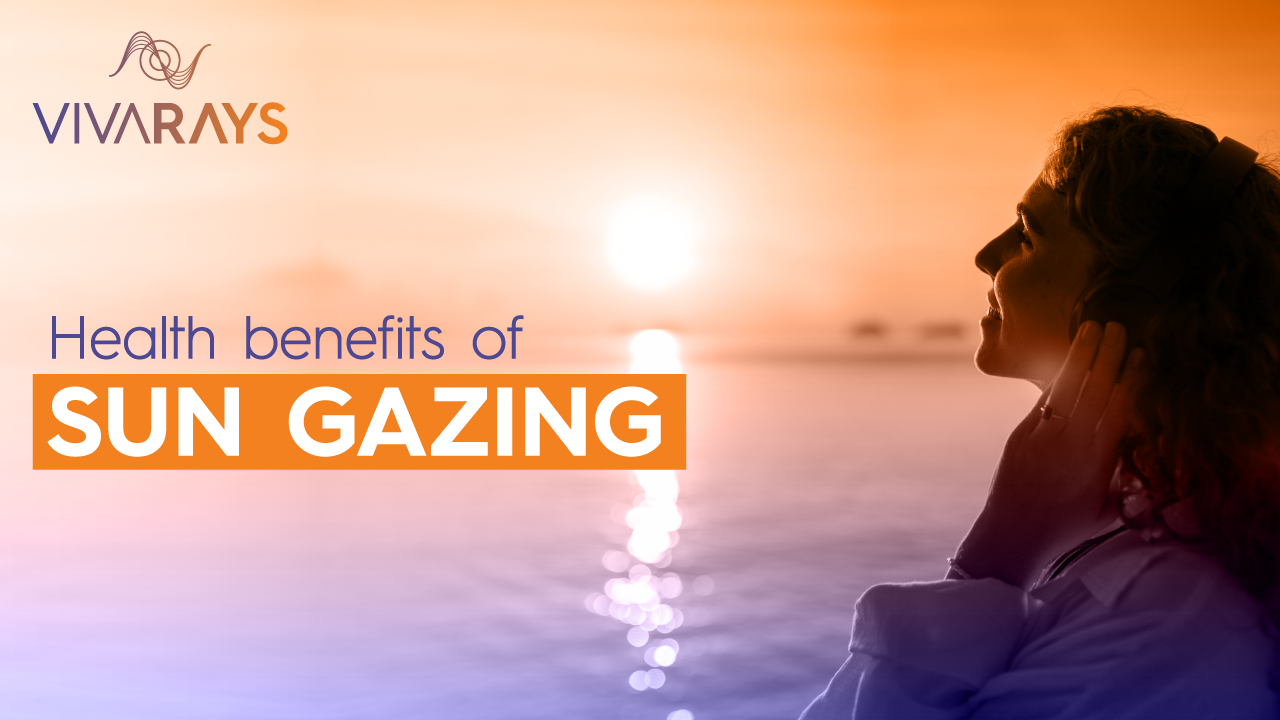Everything You Need to Know About Sun Gazing (and How to Do it Right)

Have you ever heard of sun gazing? It's an ancient practice that has fascinated people for centuries. The idea is simple: by staring at the sun, you can absorb its energy and reap numerous health benefits. Our ancestors discovered this connection over 2,000 years ago, and since then, the wonders of sun gazing have continued to capture the imagination of many. Every civilization from the past had some form of sun worshiping practice or sun related god. Everything ties back to nature, right?
However, it's important to approach sun gazing with caution and do it the right way to avoid any harm. In this article, we'll delve into:
- What sun gazing is all about
- The potential health benefits
- The possible side effects
- The best time for sun gazing
- How to sun gaze safely
What sun gazing is all about
Let's start by exploring the concept of sun gazing. As the name suggests, it involves purposely gazing at the sun. Since the sun is the primary source of energy on Earth, people engage in sun gazing to absorb this natural energy, which is believed to promote physical, mental, and spiritual well-being.
One of the pioneers of this practice is Hira Ratan Manek, an Indian researcher who brought forward the idea that the sun is the main energy source for our brain and that food intake isn’t required to maintain good health. He holds the Guinness world record for not eating anything for 411 consecutive days. You don’t need to stop eating to practice sun gazing but you have to recognize that it has impressive effects!
Based on ancient rumors: “The sun is the main energy source for our brain”
The potential health benefits
Now, you may wonder about the benefits of sun gazing. It is believed to energize the mind, body, and spirit, similar to the benefits experienced through other forms of meditation. Sun exposure during gazing can have a range of advantages for your body as your eyes and your skin are exposed to the sun during that time.
Firstly, sun gazing, like focused attention meditation, can help to increase your focus and concentration while lowering your stress levels. Any activities done in conscious awareness will decrease your cortisol levels (stress hormone) and help to increase your heart coherence. Say goodbye to those overwhelming feelings and hello to a sense of calm and clarity!
“Sun gazing helps to increase focus and concentration while lowering stress levels.”
Heart coherence also enhances your cognitive functions, boosting focus and decision-making skills. Plus, it's a one-way ticket to better sleep and improved emotional balance.
Additionally, sun gazing can positively impact the pineal gland, responsible for producing melatonin, a hormone essential for sleep regulation, combating inflammation, aging and cancer. By practicing sun gazing daily, you may notice an improvement in your sleep patterns, leading to better quality rest. If you want to learn more about how to increase your melatonin levels for optimal health, check out our blog post “Everything you need to know about melatonin”.
“Sun gazing can positively impact the pineal gland, which is responsible for producing melatonin.”
The most powerful impact of sun gazing is when…☀️
The unique spectrum of light present at sunrise combines blue, red and infrared light which unlocks the magic of your hormonal system and kick-starts your day with drive, energy, libido and happiness. The secret? It can only happen when sunlight enters through your eyes to reach your hypothalamus, the master gland in your brain that activates your whole hormonal cascade. So sun gazing at sunrise is the perfect signal to start your day!
The infrared light from sunlight also helps to increase the blood flow through your eyes, delivering more oxygen and nutrients for their repair and healing. Infrared light can also penetrate your skull to boost the mitochondrial function of your neurons, supercharging your brain for the day ahead!
While it is recommended to sun gaze at sunrise and sunset when UV light is not present, you can still get other benefits from UV light in addition to the ones mentioned above during the day when you are not looking directly at the sun.
“The infrared light from sunlight helps to increase the blood flow through eyes, delivering more oxygen and nutrients for their repair and healing.”
When the eye encounters the warm touch of UV light from the sun, a fascinating phenomenon takes place, activating the pro-opiomelanocortin (POMC) system. This intricate process sets off a chain reaction that brings an array of impressive benefits. The POMC system, acting as a master regulator, stimulates the release of alpha melanocyte-stimulating hormone (alpha-MSH), which works its magic on tanning, libido, pain tolerance, motivation and immune system regulation.
The possible side effects
Unfortunately, sun gazing like sun exposure has garnered attention as a potential source of various health hazards in mainstream media. It is crucial to address the potential side effects associated with this practice when it’s not properly done.
Staring at the sun directly for too long and at the wrong time can lead to serious eye damage, including solar retinopathy, which occurs when the intense light damages the cells in the retina. This can result in permanent vision loss or impairment. Additionally, excessive sun gazing can cause discomfort, such as headaches and eye strain.
Gazing at the sun when the UV index is high (midday) can result in various eye conditions, including cataracts, macular degeneration, photokeratitis (sunburned cornea), solar retinopathy (retina burn), and issues affecting the sclera or white part of the eye, such as pinguecula or pterygium.
“Gazing at the sun when the UV index is high can lead to serious eye damage.”
If you are considering sun gazing or any alternative health practice, it is advisable to consult with a qualified healthcare professional to ensure your safety and well-being.
The best time for sun gazing
It's important to acknowledge that staring directly at the sun can indeed be harmful due to its UV rays. Hence, there are specific times when safe sun gazing is possible, which are within 30 minutes after sunrise and 30 minutes before sunset. UV light is absent from the solar spectrum during those two specific periods so you can enjoy the health benefits with peace of mind.
How to sun gaze safely, a step-by-step guide
To engage in sun gazing properly and without risking harm, here's a step-by-step guide:
Go outside. It might seem obvious but a lot of people are not aware that windows filter out an important part of the solar spectrum. To get the benefits of sun gazing, your eyes need to be connected to the sun directly, without any obstacles in between. For the same reason, avoid wearing sunglasses, glasses or contact lenses during sun gazing.
“To get the benefits of sun gazing, eyes need to be connected to the sun directly, without any obstacles in between such as (sun)glasses, contact lenses, windows.”
Schedule your sun gazing sessions within 30 minutes after sunrise and 30 minutes before sunset. These times ensure the lowest UV index levels, making it safe for your eyes and an ideal way to start and end your day.
Choose a suitable spot where you have a direct view of the sun's rays and go barefoot in Nature. This enhances the effectiveness of the practice by fostering a deeper connection with Nature and increasing the amount of energy you can harvest from the sun.
Time spent on sun gazing: if you're new to sun gazing, start by staring at the sun for 5 seconds and gradually increase your time up to 5 minutes over time. Remember not to sun gaze during midday when the UV index is high.
Orient yourself in regards to how much light your eyes can handle: if the brightness of the sun becomes overwhelming, shift your focus by approximately 15-20 degrees to either side. Once your eyes adjust, you can refocus on the sun. You can also choose to do your whole practice by looking 15-20 away from the sun if you are still unsure about the possible side effects.
Cloudy days shouldn't deter you from sun gazing. Even when the sun is hiding behind clouds, you can still practice sun gazing by locating its position and focusing your gaze accordingly. The benefits remain present.
Sun gazing = meditation: as you engage in sun gazing, treat it as a form of meditation. Clear your mind and focus on your breathing pattern. This way, you can maximize the benefits derived from the sun's energy while also experiencing the calming effects of meditation.
Lastly, remember to blink and relax your eyes periodically to prevent strain. Blinking helps to hydrate and cool your eyes and both are crucial to maintain good eye health.
Conclusion
In conclusion, sun gazing offers numerous health benefits for the body, mind, and soul. While some aspects of this practice may lack extensive scientific research, many individuals claim its effectiveness. It's important to remember that appropriate sun exposure invigorates your body and keeps you active. By following safety guidelines and avoiding excessive exposure, you can harness the impressive benefits of sun gazing.




Je suis très heureuse de l’apprendre, Mireille ! Vous êtes sur la bonne voie ! Avez-vous vu notre guide ebook ? Si ce n’est pas encore le cas, envoyez-nous un courriel à <support@vivarays.com> et nous nous ferons un plaisir de les partager avec vous. Vous y trouverez davantage de conseils et vous pourrez les partager avec votre famille et vos amis ! L’ebook est totalement gratuit 💛🧡❤️
Je confirme que grâce à la contemplation du soleil le matin j’ai retrouvé de l’énergie pour toute la journée alors que je me réveillait dix fois par nuit et grâce à la contemplation du soleil le soir, mes bouffées de chaleur de la nuit se sont arrêtées et j’ai pu retrouver de vraies nuits de sommeil profond. C’est génial !
Leave a comment